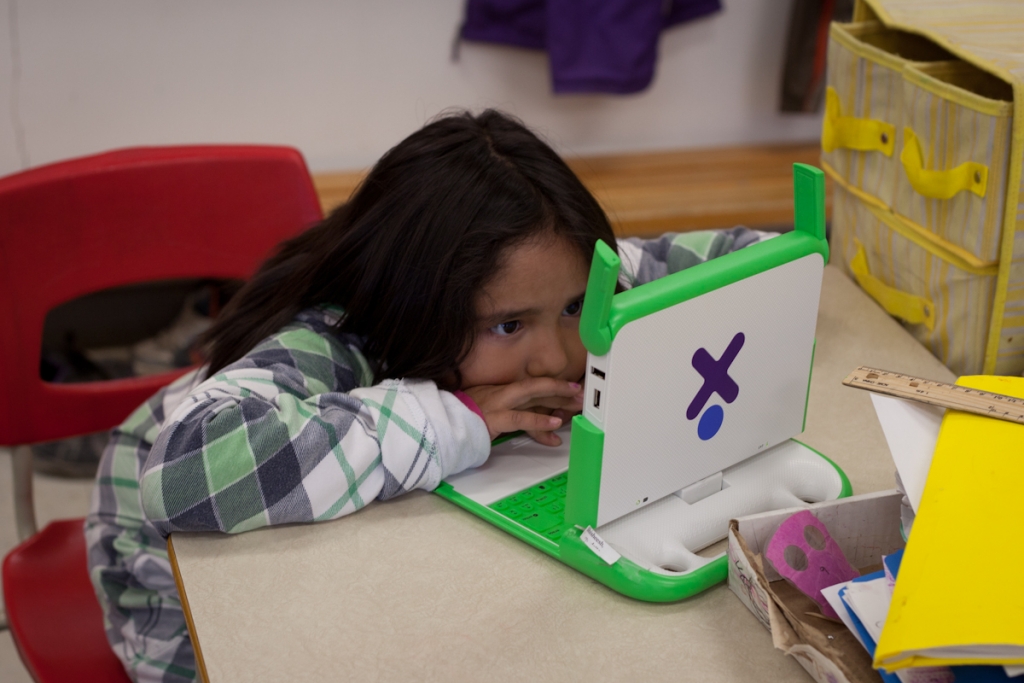The vice-principal of Attawapiskat’s elementary school says the community’s students are getting a “leg up” on their academic challenges, thanks to an international laptop program being piloted in First Nations across Canada.
Wayne Potts, vice principal at the J.R. Nakogee School, said the One Laptop per Child program, which provides a personal laptop computer for every grade one to eight student in Attawapiskat, has been a rousing success.
“It really made a difference in our school,” Potts said. “The kids are just loving them, and the teachers are very excited about this learning tool.”
The One Laptop per Child program was created to provide computers for children in some of the least developed countries on the planet. Uruguay became the first country to implement the program when its government purchased 100,000 computers in 2007. Since then laptops have been given to students in schools across the world, from Afghanistan to India, Rwanda to Peru.
Over the past year The Belinda Stronach Foundation has been bringing the program to Canada, providing laptops to 13 First Nation schools in seven provinces and two territories as a pilot project.
The laptops are built rugged, with low power consumption and low memory requirements, specifically for use by children in remote communities.
Attawapiskat was one of three schools in northern Ontario testing the project; Eabametoong First Nation and Whitefish River First Nation also were given laptops for elementary school children.
Jennifer Martino of the Belinda Stronach Foundation has been involved in bringing the program to Canada. Martino travelled the country over the past few months, spending time in nearly all of the pilot communities including Attawapiskat, where she helped teachers plan lessons using the computers and gauged how the children were reacting to the laptops.
“With this program, the technology belongs to (the students),” Martino said. “It makes a big difference when they own something, and take responsibility for it. It allows them to build their skills over time and also has an impact on their self-esteem.”
Prior to working on Canadian pilot projects, Martino was involved in implementing the program in Uruguay, where it has grown in five years to every student in the country between grades one and six owning a laptop.
Martino also helped implement the program in Peru, where the government has committed to purchasing three million laptops for school children.
In comparison to those two South American countries, Canada’s pilot programs are tiny. So far 2,600 laptops are being used across 13 schools, with another 900 computers coming over the summer.
Yet from her experiences over the past few months, Martino is just as positive about the impact the program is having in Canada as it is in South America.
“Here (in Canada) children have more access to technology, even in remote communities,” she said. “But access to technology in general is not equitable across the country. This program is designed to bridge that gap.”
Martino said that when children do not have access to technology, whether they are in Canada or a developing country, they fall behind when it comes to continuing their education or getting a job later in life.
“It’s the same everywhere,” she said. “Children in this program end up better prepared to continue on with studies and get employment opportunities.”
Potts agreed, pointing out that many of the students in Attawapiskat have already surpassed their teachers in terms of what they are able to do on the laptops.
“Kids these days are visual learners, and they are all into technology,” he said. “These laptops really captured their attention.”
The Ontario government’s Ministry of Aboriginal Affairs, the Bank of Montreal and mining company Vale are currently funding the pilot program.
Martino said that in most countries where the program has become widespread, governments take the lead on purchasing the computers and distributing them into schools.
She said the hope is that either provincial or federal governments will get on board to help take One Laptop per Child from a pilot to a full-fledged program in Canada.
Potts said that if Attawapiskat is any indication, the program would be a good fit in every school in the country.
“There are so many facets that make this such a great idea,” he said. “I think that in this day and age that for all schools in the country, and especially our First Nations in the North, to have these laptops is such a boost.”
Gold has arrived.










Gold has arrived. Here in the north of Ontario we see vast streams of gold shimmering across the landscape as autumn is here and the the leaves are turning...
I am the product, evolution of many thousands of years as are you. I grew up on the land in the remote far north of Ontario following in the footsteps of my...